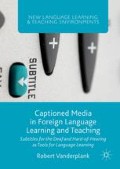Abstract
So this is the end of my story. From hopes and dreams thirty years ago to reality and disillusionment ten years later, and then a recent reawakening in a different world where the same hopes and dreams are being realised by learners through technologies, some of which were not even thought of in the world of 1980s viewing.
Access this chapter
Tax calculation will be finalised at checkout
Purchases are for personal use only
References
Bravo, M. C.C. (2008). Putting the reader in the picture: Screen translation and foreign language learning. Unpublished doctoral dissertation, Universitat Rovira I Virgili, Tarragona, Spain. Retrieved from http://tdx.cat/handle/10803/8771.
Montero Perez, M., Peters, E., & Desmet, P. (2014). Is less more? Effectiveness and perceived usefulness of keyword and full captioned video for L2 listening comprehension. ReCALL, 26(01), 21–43.
Postovsky, V. (1977). Why not start speaking later? In M. Burt, H. Dulay, & M. Finocchiaro (Eds.), Viewpoints on English as a second language (pp. 17–26). New York: Regents.
Price, K. (1983). Closed-captioned TV: An untapped resource. MATESOL Newsletter, 1–2, 1–8.
Sockett, G., & Toffoli, D. (2012). Beyond learner autonomy: A dynamic systems view of the informal learning of English in virtual online communities. ReCALL, 24(2), 138–151.
Vanderplank, R. (1999). Global medium—global resource? Perspectives and paradoxes in using authentic broadcast material for teaching and learning English. In C. Gnutzmann (Ed.), Teaching and learning English as a global language: Native and non-native perspectives (pp. 253–266). Tũbingen: Stauffenberg.
Author information
Authors and Affiliations
Copyright information
© 2016 The Author(s)
About this chapter
Cite this chapter
Vanderplank, R. (2016). Conclusion. In: Captioned Media in Foreign Language Learning and Teaching. New Language Learning and Teaching Environments. Palgrave Macmillan, London. https://doi.org/10.1057/978-1-137-50045-8_9
Download citation
DOI: https://doi.org/10.1057/978-1-137-50045-8_9
Published:
Publisher Name: Palgrave Macmillan, London
Print ISBN: 978-1-137-50044-1
Online ISBN: 978-1-137-50045-8
eBook Packages: Literature, Cultural and Media StudiesLiterature, Cultural and Media Studies (R0)

